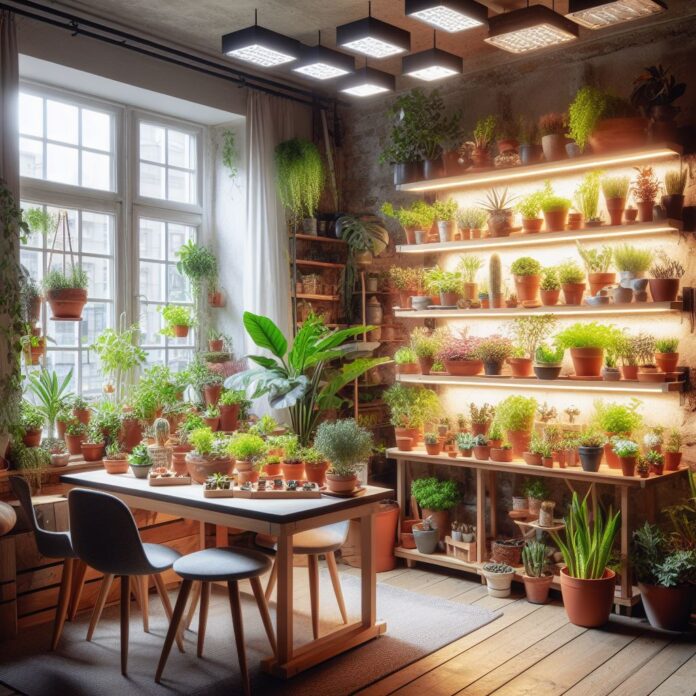Welcome to the World of Indoor Gardening
Starting an indoor garden is an exciting journey into the world of plants. It’s a way to bring a slice of nature into your home, purify your air, and even boost your mood. But if you’re a beginner, the question is: where do you start? Fear not! This article introduces you to the top 10 easy-to-grow indoor plants for beginners. Each plant comes with care instructions, ensuring your foray into gardening is enjoyable and successful. Let’s grow!
-
Spider Plant: The Resilient Air-Purifier
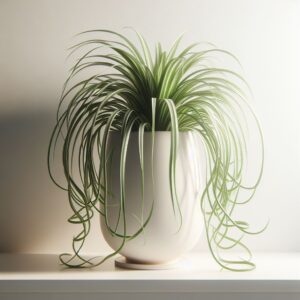
Indoor spider plant in a pot 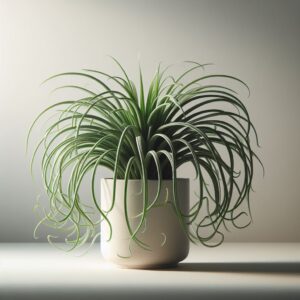
Chlorophytum comosum in a pot Overview: Understanding Spider Plants
The Spider Plant, or Chlorophytum comosum, is a paragon of indoor gardening resilience. Perfect for novices, it thrives with minimal fuss, forgiving occasional lapses in care. Its lush, green foliage and unique variegation bring a refreshing vibrancy to any indoor space. Renowned for its adaptability, the Spider Plant prospers in various light conditions, from the soft glow of indirect sunlight to the dimmer shades of a less-lit room. This versatility makes it popular, fitting seamlessly into different home aesthetics. Moreover, its air-purifying abilities work wonders, cleansing your living space of airborne toxins, thereby promoting a healthier environment.
Light and Location: Best Spots for Your Spider Plant
Identifying the ideal location for your Spider Plant enhances its growth and health. These plants are champions of adaptability, thriving in bright, indirect sunlight and tolerating lower light conditions. This adaptability ensures they fit effortlessly into numerous indoor settings. A north-facing window or a spot with filtered light is perfect. However, too much direct sunlight can scorch their leaves, so avoiding overly sunny sills is best. The Spider Plant lies in its ability to adjust, making it an excellent choice for spaces that receive varied light throughout the day. It’s this flexibility that endears it to beginners and experts alike.
Watering Wisdom: Keeping Your Spider Plant Happy
Adequate watering is crucial for a thriving Spider Plant. They favor well-drained soil and moderate watering. The key is to allow the soil to dry out somewhat between waterings, preventing root rot. Overwatering is a common misstep, especially for eager beginners, but Spider Plants are resilient. They can recover from occasional overwatering, making them a forgiving choice for those still honing their gardening skills. During winter, reduce watering frequency as the plant enters a dormant phase. This simple yet attentive approach to watering ensures your Spider Plant remains healthy, lush, and vibrant.
Air Purification: Health Benefits of Spider Plants
Spider Plants are celebrated for their air-purifying properties, making them a healthful addition to any indoor space. They excel at filtering out common household toxins such as formaldehyde and xylene. This ability to purify the air is especially beneficial in urban environments where indoor air quality can be compromised. By integrating them into your home, you contribute to a more invigorating atmosphere. It’s a natural and efficient way to enhance the air quality of your living or working space while enjoying the aesthetic benefits of these lovely plants.
Propagation and Growth: Expanding Your Spider Plant Family
Propagation is one of the most enjoyable aspects of caring for Spider Plants. They produce offshoots known as ‘pups,’ which can be easily separated and potted to grow new plants. This process is straightforward and immensely satisfying, allowing you to expand your collection or share with friends. Watching these pups take root and grow is a rewarding experience, offering a tangible connection to the cycle of life. It’s an excellent way for beginners to learn about plant reproduction and growth in a hands-on manner. The Spider Plant’s propensity for easy propagation makes it a delightful addition to any indoor garden.
Styling and Display: Decorating with Spider Plants
Spider Plants bring an elegant charm to any interior design. Their arching leaves and cascading growth make them perfect for hanging baskets or high shelves, where their foliage can elegantly spill over, creating a serene and lush ambiance. Variegated varieties, with their striking white-striped leaves, add a pop of brightness and contrast to your indoor garden. They blend well with various decor styles, from minimalist to bohemian. Placing them in different types of pots – from sleek, modern containers to more rustic, earthy pots – can significantly alter their appearance, making them versatile in complementing your home’s aesthetic.
-
Snake Plant: The Low-Maintenance Marvel
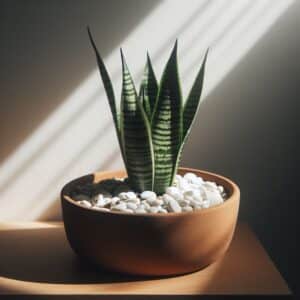
Snake plant, scientific name Sansevieria 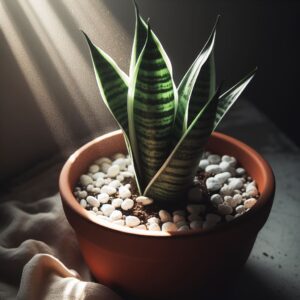
Snake plant, also known as mother-in-law’s tongue or viper’s bowstring hemp Introduction to Snake Plants
The Snake Plant, scientifically known as Sansevieria, is a steadfast warrior in the world of ideas for beginners; it boasts a striking appearance with its sword-like leaves and bold patterns. This plant is celebrated for its durability, thriving in various environments with minimal care. Its ability to withstand neglect and less-than-ideal conditions makes it a top pick for novice gardeners. The Snake Plant is more than just an attractive decor piece; it’s a hardy companion in your gardening journey, bringing both style andlicity to your indoor green space.
Ideal Lighting and Placement
Snake Plants flourish in diverse lighting conditions, from the dim corners of a room to the brighter spots near a window. They prefer indirect light but can adapt to lower light levels, showcasing their remarkable versatility. This quality allows them to be placed in various local, from bedrooms to living rooms. Their upright growth habit makes them an excellent choice for tight spaces, adding a touch of green without taking up too much room. The key is to avoid prolonged direct sunlight, which can harm their leaves.
Watering Requirements: Less is More
When it comes to watering, Snake Plants are incredibly forgiving. They require infrequent watering, thriving on neglect. The soil should be allowed to dry out completely between waterings, making them a perfect match for busy or forgetful plant owners. Overwatering is the only real threat to this resilient plant, as it can lead to root rot. This low-maintenance watering regime aligns perfectly with the busy lifestyles of many plant enthusiasts, making the Snake Plant a hassle-free choice for your indoor garden.
Air-Purifying Qualities of Snake Plants
One of the standout features of Snake Plants is their air-purifying capabilities. They excel at removing toxins such as benzene and formaldehyde from the air, contributing to a healthier living space. This feature is precious, where air quality can be compromised. By including Snake Plants in your indoor environment, you enhance the aesthetic and actively improve the air you breathe.
Growth and Care: Keeping Your Snake Plant Thriving
Caring for a Snake Plant is straightforward and undemanding. They are slow-growers, requiring little attention and infrequent repotting. This low-maintenance nature makes them ideal for beginners or those with a busy schedule. Despite their easygoing demeanor, they bring a vital architectural element to any space. Their vertical growth pattern and striking leaf patterns make them a dynamic addition to any indoor garden.
Design Tips: Incorporating Snake Plants into Your Decor
Snake Plants delights designers, bringing structure and elegance to any indoor setting. Their tall, upright leaves work well as natural art pieces, creating focal points in a room. They pair beautifully with modern and traditional decor, adding a fresh and lively element to your home. Whether placed in a sleek, contemporary planter or a more classic pot, Snake Plants makes a bold statement, enhancing the overall aesthetic of your living space.
-
Pothos: The Fast-Growing, Forgiving Vine
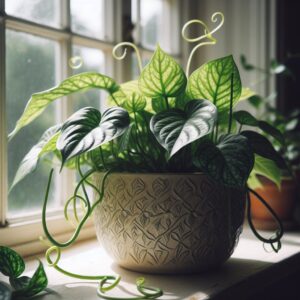
Pothos in a pot beside the window 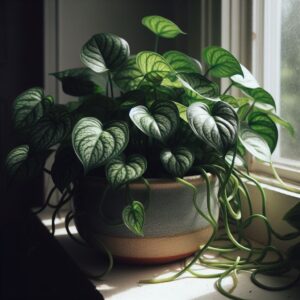
Epipremnum aureum Getting to Know Pothos Plants
Pothos, or Epipremnum aureum, is celebrated in the indoor plant community. Its rapid growth and hardiness make it a favorite among beginners. Known for their heart-shaped, variegated leaves, Pothos plants bring a lively touch to any space. They are incredibly forgiving, making them perfect for those still learning the ropes of plant care. Their versatility and ease of maintenance have cemented their status as a must-have in home gardens.
Light Requirements: Finding the Perfect Spot
Pothos plants are flexible when it comes to their light needs. They thrive in everything from low light to bright, indirect sunlight. This adaptability makes them suitable for various indoor, from dimly lit bedrooms to well-lit living rooms. However, to maintain indirect sunlight is preferable. This level of maintaining their vibrant variegation versatility is rare, making Pothos an ideal choice for various lighting conditions.
Watering Guide: Maintaining a Healthy Pothos
Watering your Pothos correctly is vital for its health. These plants prefer their soil to dry out a bit between waterings. Overwatering can lead to root rot, so ensure good drainage. Their tolerance for dry periods makes them forgiving for those who might occasionally forget to water. This easygoing nature regarding watering requirements makes Pothos a low-maintenance choice for beginners.
Benefits: Air Purification and Beyond
Apart from their aesthetic appeal, Pothos plants are known for their air-purifying abilities. They effectively remove toxins like formaldehyde and benzene from the air. This quality makes them a decorative addition and a beneficial one for improving indoor air quality. Incorporating Pothos into your home contributes to a healthier living environment.
Propagation and Growth: Expanding Your Pothos Collection
Pothos plants are a joy to propagate. Their rapid growth allows you to create new plants from cuttings easily. This aspect of Potho’s care is gratifying, enabling you to expand and share your collection with others. Watching new roots and leaves emerge is a delightful experience, offering insight into the plant’s growth process.
Decorating with Pothos: Creative Ideas
Pothos plants are incredibly versatile in home decor. Their trailing vines can be styled in hanging baskets, creating a lush, green cascade. Alternatively, they can be trained to climb on supports, adding a vertical element to your space. Their fast growth and cascading vines offer endless possibilities for creative display, enhancing the overall ambiance of your home.
-
Peace Lily: The Elegant Shade-Lover
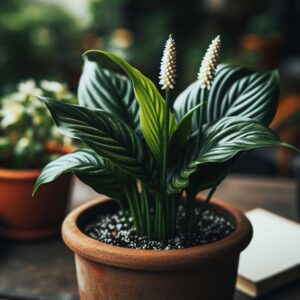
Spathiphyllum indoor 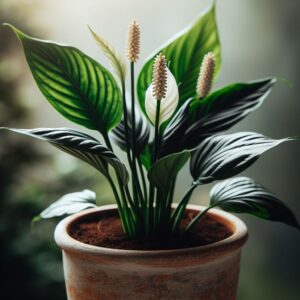
Indoor Peace Lily in a pot Exploring the Peace Lily
The Peace Lily, or Spathiphyllum, is a gem in houseplants. Known for its striking white flowers and dark green leaves, it adds a touch of elegance to any indoor setting. This plant is favored for its ability to thrive in lower light conditions, making it suitable for areas in your home that may not receive ample sunlight. Its ease of care and stunning appearance make it a popular choice for novice and experienced gardeners. The Peace Lily’s ability to signal its watering needs makes it a practical and beautiful addition to any space.
Ideal Lighting for Peace Lilies
Peace Lilies perform best in low to medium light, avoiding direct sunlight. They are perfect for areas with filtered light, like near a north-facing window or a room with sheer curtains. This flexibility in lighting requirements allows them to be placed in various locations around your home, making them versatile and adaptable. The lighting conditions ensure that Peace Lilies bloom beautifully, displaying their characteristic white flowers that enhance their appeal.
Watering Your Peace Lily Correctly
Watering is crucial for Peace Lilies. They prefer their soil to be consistently moist but not soggy. It’s essential to allow the top inch of soil to dry out before watering again. Overwatering can lead to root rot, so proper drainage is necessary. Peace Lilies will let you know when they need water – their leaves will droop, signaling it’s time to water. This visual cue makes them user-friendly for beginners, as it takes the guesswork out of watering.
Air-Purifying Features of Peace Lilies
Peace Lilies are not just visually appealing but also excellent air purifiers. They filter out various toxins from indoor air, such as formaldehyde and ammonia. This makes them a healthful addition to any indoor environment, contributing to cleaner, fresher air. Incorporating Peace Lilies into your home or office can improve the overall air quality of your living or working space.
Caring for Your Peace Lily: Growth and Maintenance
Peace Lilies are relatively easy to care for. They require minimal maintenance and are forgiving of occasional neglect. Regular pruning and cleaning of their leaves keep the plant attractive and promote healthy growth. Their fast growth rate and ease of propagation allow you to expand your collection or share with others easily. The Peace Lily is a rewarding plant that offers beauty and a sense of achievement in its care.
Interior Design: Styling with Peace Lilies
In terms of decor, Peace Lilies brings a sophisticated and tranquil vibe to any space. Their elegant flowers and lush foliage make them ideal as standalone plants or as part of a larger plant arrangement. They work well in various interior styles, from modern minimalist to more traditional settings. Placing them in decorative pots can enhance their aesthetic appeal, making them a versatile and attractive addition to your indoor garden.
-
Aloe Vera: The Healing Succulent
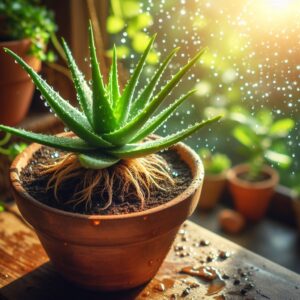
Aloe Vera 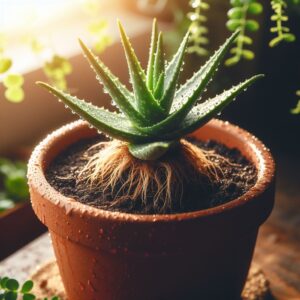
The Healing Succulent Introduction to Aloe Vera
Aloe Vera is more than just a plant; it’s a natural healer. Renowned for its medicinal properties and easy care, Aloe Vera is a must-have in any indoor garden. Its distinctive appearance, with thick, spiky leaves, adds a unique touch to your home. Aloe Vera is not only about aesthetics; its health benefits make it a practical choice for plant enthusiasts. Its ability to thrive with minimal care makes it ideal for beginners or those looking for low-maintenance plants.
Sunlight Needs: Best Practices for Aloe Vera
Aloe Vera loves the sun. A bright, sunny spot, preferably a south-facing window, is ideal. While it requires ample light, protecting it from the harsh midday sun, which can scorch its leaves, is essential. This plant’s preference for bright light aligns with its desert origins. Ensuring the right amount of sunlight is critical to keeping your Aloe Vera healthy and thriving.
Watering Aloe Vera: Tips for Success
Watering Aloe Vera correctly is crucial for its survival. This succulent prefers infrequent watering, allowing the soil to dry entirely between sessions. Overwatering is the most common mistake and can lead to root rot. Its drought-tolerant nature makes it forgiving if you occasionally forget to water. This low-maintenance watering approach is perfect for those with a busy lifestyle or less experience in plant care.
Health Benefits: Aloe Vera’s Medicinal Properties
Aloe Vera is celebrated for its health benefits. The gel inside the leaves is used for soothing burns, cuts, and skin irritations. It’s also popular in skincare products for its moisturizing and healing properties. Having an Aloe Vera plant means having a natural remedy, making it a practical addition to any home.
Growth and Propagation: Expanding Your Aloe Collection
Propagation of Aloe Vera is simple. It produces “pups” that can be separated and repotted. This easy propagation method allows you to expand your collection or share with friends and family. Watching these new plants grow is a rewarding experience, adding to the joy of indoor gardening.
Decorating with Aloe Vera: Aesthetic and Functional
Aloe vera is not only functional but also aesthetically pleasing. Its bold architectural form makes it a striking addition to any room. Whether placed on a sunny windowsill or in a modern living space, aloe vera brings a touch of nature’s beauty indoors. Its practical benefits and stylish appearance make it a favorite among plant lovers.
-
ZZ Plant: The Drought-Tolerant Decorator
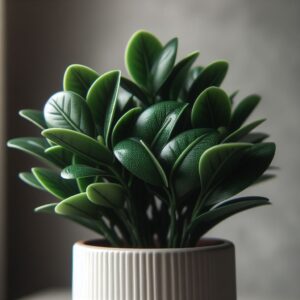
Zamioculcas zamiifolia 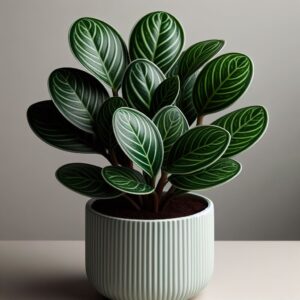
ZZ Plant in a pot Getting to Know the ZZ Plant
The ZZ Plant, or Zamioculcas zamiifolia, is a marvel of nature’s design. Known for its waxy, shiny leaves and robust structure, it’s famous for indoor gardeners. This plant is practically indestructible, thriving under neglect and in various indoor conditions. Its resilience and low maintenance make it ideal for beginners or those seeking an easy-care plant.
Lighting and Location: Ideal Conditions for ZZ Plants
ZZ Plants are versatile in their lighting needs. They tolerate low light well, making them suitable for dimmer areas of your home. However, they also adapt to brighter spots, though direct sunlight should be avoided. This adaptability in light conditions makes them perfect for various indoor settings, from offices to living rooms.
Watering Wisdom: ZZ Plant Care
Watering a ZZ Plant is straightforward. It prefers infrequent watering, thriving on minimal attention. The key is to allow the soil to dry out completely between waterings. Overwatering can harm this plant, so it’s important to err on the side of underwatering. This low-maintenance watering regime is perfect for busy individuals or those new to plant care.
Air Quality Improvement: ZZ Plant Benefits
Besides its aesthetic appeal, the ZZ Plant is known for its air-purifying qualities. It helps remove pollutants from indoor air, contributing to a healthier living environment. Adding a ZZ Plant to your home enhances the decor and improves the air quality, making it a wise choice for any indoor space.
Maintaining and Propagating Your ZZ Plant
The ZZ Plant is easy to care for and maintain. It grows slowly and requires little attention, making it a fuss-free option for indoor gardeners. Propagation is also simple, allowing you to expand your collection or share with others. The plant’s resilience and ease of care make it a rewarding choice for novice and experienced plant enthusiasts.
ZZ Plant in Home Decor: Styling Tips
In terms of decor, the ZZ Plant is a versatile player. Its glossy leaves and upright growth add a touch of elegance to any space. Whether placed in a minimalist or more traditional environment, the ZZ Plant fits in seamlessly. Its ability to enhance a variety of decor styles makes it a favorite among interior design enthusiasts.
-
Rubber Plant: The Bold Foliage Favorite
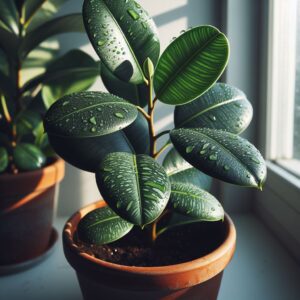
Rubber Plant beside a window 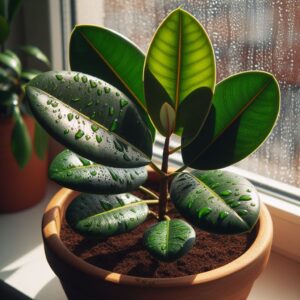
Ficus elastica Introduction to Rubber Plants
The Rubber Plant, or Ficus elastica, is a captivating addition to any indoor garden. Known for its large, glossy leaves, it creates a dramatic visual impact. This plant’s robust stature and lush foliage bring a tropical ambiance to your home. Ideal for beginners, it demands little but gives much in return. Its air-purifying qualities enhance your living space’s health, filtering out common indoor toxins. The Rubber Plant is not just about aesthetics; its ability to grow indoors with minimal fuss makes it a practical choice for busy plant lovers. A symbol of endurance and growth, it reflects the resilience and adaptability necessary daily. By incorporating a Rubber Plant into your indoor garden, you’re not just adding a piece of greenery but infusing your space with life and vitality.
Optimal Light and Placement for Rubber Plants
The Rubber Plant flourishes in bright, indirect sunlight but can adapt to medium light conditions, making it suitable for various indoor settings. It’s a versatile plant that can be placed in different areas of your home, from a cozy corner in your living room to a bright spot near a window. While it enjoys light, it must be shielded from harsh, direct rays that can damage its leaves. A place that receives filtered sunlight throughout the day is ideal. This allows the Rubber Plant to thrive and maintain its vibrant green leaves. Additionally, considering its potential to grow quite tall, it is crucial to choose a location where it can stretch upwards without constraint. The Rubber Plant’s adaptability to light conditions makes it an excellent option for spaces that might not be suitable for more light-sensitive plants.
Watering Guidelines for Healthy Growth
Watering the Rubber Plant correctly is essential for its well-being. This plant prefers a balance in soil moisture – it should be neither wet nor dry. The watering frequency depends on the light and temperature conditions. It may require more frequent watering in brighter light, while in lower light, it is less frequent. The key is to check the soil moisture regularly – if the top inch of the soil feels dry, it’s time to water. During the winter, reduce watering as the plant’s growth slows down. Proper drainage is critical to avoid waterlogging the roots, as this can lead to root rot, a common problem in overwatered Rubber Plants. Consistent watering, adjusted for seasonal changes and environmental conditions, will ensure your Rubber Plant remains healthy and thrives, showcasing its striking foliage.
Air Purifying Abilities of Rubber Plants
The Rubber Plant is not only a decorative asset but also an environmental one. It is known for its ability to purify the air by filtering toxins like formaldehyde, commonly found in indoor environments. This natural air-filtering property makes the Rubber Plant a valuable addition to any home or office space, contributing to a healthier and more pleasant living environment. The large surface area of its leaves increases its effectiveness in cleaning the air. By incorporating a Rubber Plant in your indoor space, you are doing more than just beautifying your surroundings; you are actively improving the air quality, creating a healthier space for you and your family. This feature is particularly beneficial in urban areas where indoor air quality is often compromised. The Rubber Plant’s air-purifying abilities and aesthetic appeal make it a wise and healthful choice for any indoor gardener.
Growth and Care: Ensuring Longevity
Rubber Plants are known for their impressive growth and can become quite large, making them excellent statement pieces in any room. They grow upright and can reach significant heights, adding a dramatic touch to your indoor garden. Regular care is essential to ensure their health and longevity. This includes periodic pruning to maintain their shape and encourage fuller growth. Pruning also helps to manage their size, making them suitable for different indoor spaces.
Decorating with Rubber Plants: Design Ideas
The Rubber Plant is a versatile decorator in the world of indoor plants. Its bold, glossy leaves make a strong design statement, adding a touch of elegance to any interior. They fit well in various decorative styles, from modern minimalist to bohemian chic. Due to their potential size, they work well as focal points in a room, whether placed in a large decorative pot on the floor or a pedestal. Their lush, green leaves bring a vibrant burst of life to any space, creating a welcoming and refreshing atmosphere. Rubber Plants can create a diverse and engaging indoor garden when paired with other plants. Their robust and upright growth pattern contrasts beautifully with more delicate, trailing plants, adding depth and interest to your display. Whether you want to create a bold statement or add a touch of greenery to your space, the Rubber Plant is a versatile and rewarding option.
Additionally, keeping their leaves clean not only enhances their glossy appearance but also supports their health by ensuring efficient photosynthesis. Dust accumulation on leaves can hinder their ability to absorb light. Rubber Plants may occasionally be susceptible to pests, so regular check-ups are essential. With proper care and attention, Rubber Plants can live for many years, becoming a longstanding and cherished part of your indoor garden.
-
Philodendron: The Heart-Leafed Classic
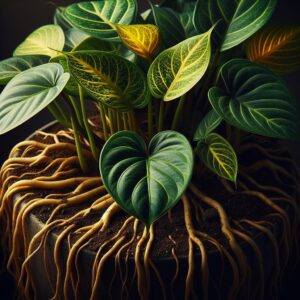
Philodendrons 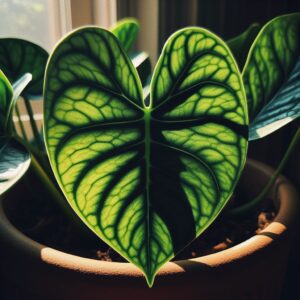
Heart-shaped leaves of Philodendrons Discovering Philodendrons
With their heart-shaped leaves and lush growth, Philodendrons are a favorite in houseplants. Ideal for beginners, they offer both beauty and ease of care. Their versatility makes them well-suited for various indoor environments. These plants are easy on the eyes and adaptable, thriving under a range of conditions. They bring a tropical feel to any room, creating a relaxing and natural ambiance. Philodendrons symbolize growth and health, making them a meaningful addition to your home. Their ability to purify the air adds to their appeal, making them a popular choice for enhancing indoor spaces. Whether new to plant care or a seasoned enthusiast, Philodendrons offers a delightful blend of visual appeal and practical benefits.
Lighting Needs for Thriving Philodendrons
Philodendrons excel in medium to bright, indirect light but tolerate lower light levels. This adaptability makes them suitable for many areas, from a shaded bedroom corner to a well-lit living room. However, it’s essential to avoid direct sunlight, which can scorch their delicate leaves. The right lighting conditions are crucial for maintaining their vibrant green foliage and promoting healthy growth. Philodendrons’ flexible light requirements make them a go-to choice for spots where other plants might struggle. Their love for indirect light aligns with their tropical origins, where they flourish under the canopy of rainforests. By mimicking these conditions, you can ensure your Philodendron thrives, adding lush, green beauty to your indoor space.
Watering Your Philodendron Effectively
Proper watering is essential for Philodendron health. These plants prefer their soil to dry out slightly between waterings. Overwatering can lead to root rot, so having well-draining soil and pots is essential. A regular check on soil moisture helps avoid water stress. Philodendrons are forgiving if you forget to water them occasionally, making them suitable for busy or forgetful gardeners. Their ability to tolerate irregular watering schedules increases their popularity among indoor plants. A consistent watering routine, adjusted for seasonal changes, ensures your Philodendron stays hydrated and healthy. This approach to watering, combined with their adaptable nature, makes Philodendrons a resilient and rewarding choice for indoor gardens.
Philodendron as an Air Purifier
Philodendrons are not just visually pleasing; they also play a vital role in purifying indoor air. They are efficient at removing toxins like formaldehyde and other volatile organic compounds. This air-cleaning ability makes Philodendrons an intelligent choice for improving the air quality in your home. Having a Philodendron can make a significant difference in today’s urban environments, where indoor air can be more polluted than outdoor air. By filtering harmful substances, they create a healthier and more comfortable living space. Adding Philodendrons to your indoor environment means you’re not just decorating your space but also actively contributing to a cleaner and healthier atmosphere.
Propagating and Growing Philodendrons
One of the joys of owning Philodendrons is their ease of propagation. They can be easily propagated through stem cuttings, making it simple to expand your collection or share with friends. Watching a new plant grow from a cutting is a rewarding experience, especially for beginners. This aspect of Philodendron care is practical and educational, offering insight into the plant’s life cycle. With proper care and propagation, Philodendrons can become a long-lasting part of your indoor garden, growing and adapting alongside you.
Incorporating Philodendrons into Your Home Decor
Philodendrons are a versatile choice for home decor. Their trailing vines are perfect for hanging baskets, creating a cascading green effect. They can also be trained to climb, adding a vertical element to your indoor garden. Their lush foliage complements various interior styles, from minimalist to eclectic. Placing them in different containers can change their overall look, making them adaptable to your decor style. Whether used as a standalone plant or part of a larger arrangement, Philodendrons bring nature’s beauty to your home.
-
English Ivy: The Versatile Climber
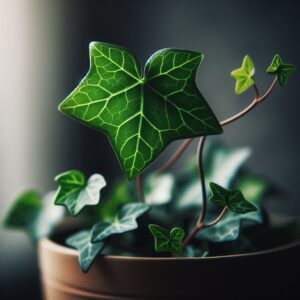
English Ivy in a pot 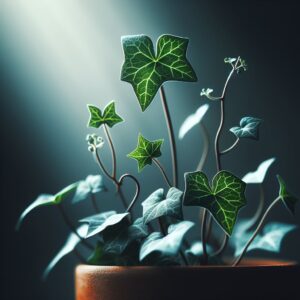
Hedera helix in sunlight An Overview of English Ivy
English Ivy, or Hedera helix, is a classic and versatile plant, ideal for indoor gardens. Famous for its climbing and trailing abilities, it adds a touch of elegance and timelessness to any space. Perfect for beginners, English Ivy adapts well to indoor environments and requires minimal care. This plant is more than just an ornamental addition; it’s a living art that transforms spaces with lush, green vines. English Ivy symbolizes growth, fidelity, and longevity, making it a meaningful choice for your home. Its air-purifying capabilities further enhance its appeal, making it a popular choice for improving indoor air quality.
Lighting Considerations for English Ivy
English Ivy thrives in moderate to bright, indirect light, encouraging healthy growth and vibrant foliage. It can also adapt to lower light conditions, making it suitable for less sunny spaces. However, too much direct sunlight can harm its delicate leaves, so finding the right balance is critical. A location with filtered light, such as near a window with sheer curtains, is ideal. This plant’s ability to adapt to different light levels makes it versatile and easy to incorporate into various indoor settings. Whether you place it in a bright bathroom or a dimly lit office, English Ivy will adjust and thrive, bringing its unique charm to your space.
Watering English Ivy: Best Practices
Consistent moisture is essential for English Ivy, but avoiding overwatering is crucial. Ensure the soil is well-draining and allow the top inch to dry before watering again. This plant is sensitive to waterlogged soil, which can lead to root rot. Maintaining a stable watering routine, especially during the growing season, ensures your Ivy remains healthy. During the winter months, reduce watering as the plant’s growth slows. English Ivy’s preference for consistent, but not excessive, watering aligns with its natural habitat in woodlands and forests. You can keep your Ivy thriving by replicating these conditions, adding a lush green accent to your indoor garden.
Air Purification and Health Benefits
English Ivy is renowned for its air-purifying properties. It excels at removing toxins such as formaldehyde and benzene from the air. This makes it a valuable addition to any home, especially in urban areas where indoor air quality can be compromised. By filtering harmful substances, English Ivy contributes to a healthier living environment. Its ability to improve air quality and its decorative appeal make it a wise choice for anyone looking to enhance their indoor space.
Caring and Propagating English Ivy
Caring for English Ivy involves regular maintenance to keep it looking its best. Pruning helps control its growth and encourages a fuller, denser appearance. Propagation is straightforward, making expanding your collection or sharing with others easy. This plant’s fast growth and ease of care make it a satisfying choice for beginner and experienced gardeners. Regular check-ups for pests and diseases will keep your Ivy in top condition, ensuring it beautifies your space for years.
Design Tips: English Ivy in Home Styling
English Ivy’s flexibility in styling makes it a favorite among interior designers. Its trailing vines are perfect for hanging baskets, creating a cascade of greenery. It can also be trained to climb, adding a vertical element to walls or trellises. This plant complements various decor styles, from rustic to contemporary, adding a touch of nature’s charm. Whether used as a statement piece or part of a larger plant arrangement, English Ivy enhances the aesthetic of any room.
-
Jade Plant: The Lucky Succulent
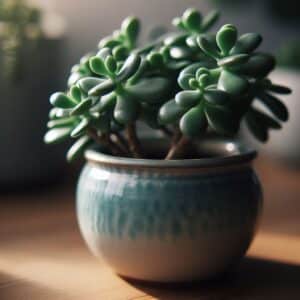
Jade Plant in a pot 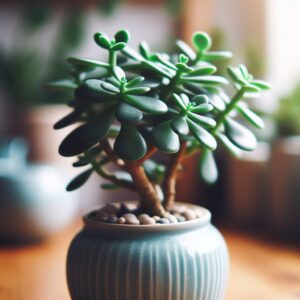
Crassula ovata Introduction to Jade Plants
The Jade Plant, known scientifically as Crassula ovata, is more than just a succulent – it’s a symbol of good luck and prosperity. Its thick, glossy leaves and sturdy branches bring aesthetic appeal and a sense of serenity to any indoor setting. Perfect for beginners, Jade Plants require minimal care, thriving under bare attention. They’re long-lived, often becoming cherished in homes for many years. Their ease of care and attractive, tree-like appearance make them a popular choice for indoor gardeners. According to popular belief, adding a Jade Plant to your space enhances its beauty and invites positive energy.
Sunlight and Location: Perfect Spots for Jade Plants
Jade Plants love sunlight and thrive in bright, indirect light. A sunny windowsill is ideal, providing them with the light they need while protecting them from harsh afternoon rays. They can tolerate direct morning sun, which promotes healthy growth and leaf coloration. Rotating your Jade Plant periodically is important to ensure even growth on all sides. This plant’s preference for bright light mirrors its natural habitat in sunny, dry regions. By providing ample light, you encourage more substantial, robust growth, allowing your Jade Plant to flourish and become a striking feature in your indoor garden.
Watering Your Jade Plant: Key Tips
Watering your Jade Plant correctly is crucial for its health. These succulents store water in their leaves, enabling them to withstand dry periods. Allow the soil to dry out completely between waterings, and then water thoroughly. Overwatering is a common mistake and can lead to root rot. In the winter, reduce watering frequency to mimic the plant’s natural dormant period. This less-is-more approach to watering aligns with the Jade Plant’s drought-tolerant nature. Adhering to this simple watering schedule, you help ensure your Jade Plant stays healthy and vibrant for years.
Jade Plant: A Symbol of Prosperity and Purification
The Jade Plant is often associated with good luck and prosperity, making it a popular gift and a cherished plant in many cultures. It’s believed to bring financial success and good fortune to its owners. Beyond its symbolic significance, the Jade Plant is known for its air-purifying abilities. It helps remove harmful toxins from the air, contributing to a healthier indoor environment. This combination of aesthetic appeal, symbolic meaning, and health benefits makes the Jade Plant a multifaceted addition to any indoor space.
Propagation and Care: Growing Your Jade Plant Collection
Propagating a Jade Plant is a simple and rewarding process. Leaf or stem cuttings root easily, allowing you to expand your collection or share with friends and family. This easy propagation adds to the joy of owning a Jade Plant, as you can watch new plants grow from cuttings. Regular care, including occasional pruning and repotting, keeps your Jade Plant healthy. Jade Plants can grow into impressive specimens with proper attention, showcasing their thick, woody stems and lush, green leaves.
Decorative Ideas: Styling with Jade Plants
Jade Plants are versatile in home decor, adding a touch of elegance and natural beauty. Their compact size and tree-like appearance make them ideal for tabletops, desks, or as part of a larger plant display. They complement various interior styles, from modern minimalist to more eclectic decor. Placing them in decorative pots can enhance their appeal, making them a focal point in any room. Whether used as a standalone plant or with other succulents, Jade Plants bring a calming and refreshing element to your indoor space.
Embracing the Green: The Final Word on Indoor Gardening
As we conclude our exploration of these ten remarkable indoor plants, it’s essential to recognize the broader impact of indoor gardening. Recent studies have shown that indoor plants can reduce stress levels, with one study noting a 37% reduction in tension and anxiety among participants who spent time around plants. Furthermore, research by NASA has highlighted the significant role of houseplants in purifying air, removing up to 87% of air toxins in 24 hours.
Indoor gardening is more than a hobby; it’s a lifestyle choice that promotes well-being. Plants in living spaces have been linked to enhanced creativity and productivity, with a 15% increase observed in tasks performed in environments with greenery. The psychological benefits are equally impressive, as interacting with plants can lower blood pressure and improve mood.
The plants we’ve explored – from the resilient Spider Plant to the auspicious Jade Plant – bring unique charm and benefits. They transform living spaces not just aesthetically but also environmentally and emotionally. With more than 30% of households now engaging in indoor gardening, it’s clear that the trend is not just about beautifying spaces; it’s about enriching lives.
As you embark on or continue your journey in indoor gardening, remember that each plant you nurture contributes to a greener, healthier, and more harmonious world. Whether you’re drawn to the Snake Plant’s air-purifying qualities or the Aloe Vera’s soothing presence, your indoor garden is a testament to the beauty and resilience of nature. So, embrace the green, and let your indoor garden be a sanctuary for you and the environment.
Happy gardening, and may your home flourish with the lushness and vitality that only nature can provide!


